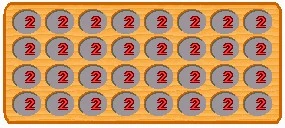| Kanotta |
| First Description: J. H. Chaplin, 1956 |
| Cycles: Two |
| Ranks: Four |
| Sowing: Multiple laps |
| Region: Zambia |
Kanotta is played by the Lunda in the Mwinilunga District in the extreme northwest of Zambia, where it meets Angola and Congo. The Lunda number about 1.45 million people, who live in southern DR Congo, eastern Angola and the North-Western Province of Zambia. They were prosperous fishermen and farmers. In the 17th century they formed the Lunda Empire, a pre-colonial African confederation of states, under their ruler, Mwata Yamvo or Mwaant Yav, with their capital at Musumba.
Like many other four-rank games, Kanotta was first described by J. H. Chaplin in 1956 in "A Note on Mancala Games in Northern Rhodesia".
Rules
Kanotta is played with 64 seeds on a four-row board, each row having eight holes.
Initial Position
After the starting position has been set, the players remove the contents of four holes of their opponent in their first move.
Afer that, a player sows the contents of one of his holes, which has at least two stones, counterclockwise into consecutive holes, stone by stone, around his two rows.
If the hole, in which the lap ended, was occupied, its contents are lifted for another lap.
If a player has only singles left, he must if possible sow a single seed into an adjacent hole that is occupied.
If the lap ended in an empty hole, the move is over.
If the last seed ended in an empty hole of the player's front row and the opponent's hole opposite to it was occupied, the contents of both holes of the opponent's file are captured. In addition, the contents of any other two of his opponent's holes are also taken. If, however, the hole of the opponent's inner row was empty, nothing is captured.
All captures are removed from the board.
The game ends when a player has no stones left.
The player who has still stones at the end of the game wins.
References
- Chaplin, J. H.
- A Note on Mancala Games in Northern Rhodesia. In: Man: The Journal of the Royal Anthropological Institute 1956; 56 (12): 168-170.
Copyright
By: © Ralf Gering
Under the CC by-sa 2.5 license.
